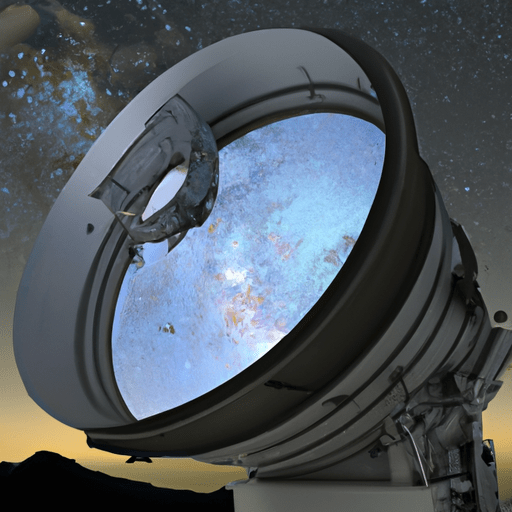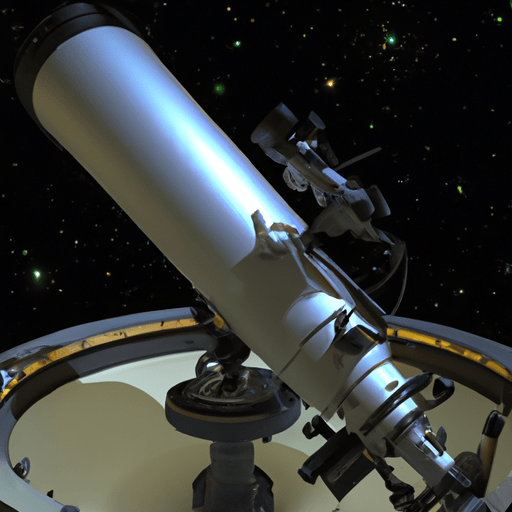Have you ever wondered about the fascinating way telescopes enable us to explore the wonders of the universe? It’s truly remarkable! Telescopes expand our view beyond what the naked eye can perceive, revealing the beauty and mysteries of celestial objects. So, how do these remarkable devices actually work?
Telescopes function by collecting and magnifying light, allowing us to see distant objects in greater detail. They achieve this through a combination of lenses or mirrors. The primary function is to gather as much light as possible. The larger the telescope, the more light it can collect, resulting in clearer and more detailed images. Once the light enters the telescope, it travels through a series of lenses or mirrors that focus and direct it towards the eyepiece or camera. Through this process, telescopes bring the wonders of the universe closer to our eyes, unraveling its secrets and expanding our understanding of the cosmos.

Telescope Basics
History of telescopes
Telescopes have a rich history that dates back to ancient times. The earliest known telescopes were developed in the 17th century, with notable contributions from astronomers such as Galileo Galilei. These early telescopes utilized lenses to gather and focus light, allowing observers to see distant objects with enhanced clarity. Over the years, the design and functionality of telescopes have evolved significantly, leading to the development of advanced instruments used by both amateur and professional astronomers today.
Types of telescopes
There are several different types of telescopes, each designed for specific purposes. The most common types include refracting telescopes, reflecting telescopes, and catadioptric telescopes. Refracting telescopes, also known as refractors, use lenses to gather light and form an image. Reflecting telescopes, on the other hand, use mirrors to gather and focus light. Catadioptric telescopes combine both lenses and mirrors to form an image, offering a compact and versatile design. Each type of telescope has its advantages and disadvantages, making them suitable for different observation needs.
Light and Optics
Basics of light
To understand how telescopes work, it is essential to have a basic understanding of light. Light is a form of electromagnetic radiation that travels in waves. It consists of particles called photons, which carry energy. The intensity, color, and direction of light can provide valuable information about the objects it interacts with. Telescopes utilize light to observe and study celestial objects, allowing us to explore the vastness of the universe.
Refraction and reflection
Two fundamental principles of optics, refraction and reflection, play a crucial role in telescopes. Refraction occurs when light passes through a medium, such as glass or water, causing the light waves to change direction. This phenomenon is essential in refracting telescopes, where the objective lens bends incoming light to form an image. Reflection, on the other hand, occurs when light bounces off a surface. Reflecting telescopes use mirrors to gather and reflect light, allowing observers to observe celestial objects clearly.
Principles of optics
Telescopes rely on several principles of optics to provide clear and magnified images. One of these principles is the formation of an image through the convergence or divergence of light rays. The objective or primary mirror/lens gathers incoming light and focuses it at a specific point, known as the focal point. The eyepiece, positioned at the focal point, then magnifies the image formed by the primary mirror/lens, allowing observers to see distant objects in greater detail. The combination of these optical principles helps create a clear and magnified view of celestial objects.
Telescope Components
Objective or primary mirror
The objective or primary mirror is one of the most critical components of a telescope. In reflecting telescopes, it is a concave mirror that collects and focuses incoming light. The shape and quality of the mirror directly affect the performance and clarity of the telescope’s images. A larger primary mirror allows for greater light-gathering ability and higher resolution, enabling observers to see fainter and more detailed celestial objects.
Eyepiece
The eyepiece is another crucial component of a telescope. It is responsible for magnifying the image formed by the objective lens or mirror. Eyepieces come in different designs and focal lengths, each offering a unique viewing experience. Higher focal length eyepieces provide higher magnification, while lower focal length eyepieces offer a wider field of view. Choosing the right eyepiece is essential to achieve the desired level of magnification and field of view for a particular observation.
Focuser
The focuser is responsible for adjusting the position of the eyepiece, allowing observers to achieve the desired focus. It enables the fine-tuning of the telescope’s optics to create a sharp image. Modern telescopes often feature dual-speed focusers, which provide precise control over the focusing process, enhancing the overall viewing experience.
Mount
The mount is the mechanism that supports and allows the movement of the telescope. There are two primary types of mounts: altitude-azimuth (alt-az) and equatorial. Alt-az mounts allow for easy movement in both horizontal (azimuth) and vertical (altitude) directions, making them suitable for general observations. Equatorial mounts, on the other hand, are designed to align with the rotational axis of the Earth, allowing for accurate tracking of celestial objects. Mounts can be motorized or manual, with motorized mounts offering the convenience of automated tracking.
Tripod
The tripod is the supporting structure that holds the telescope and mount. It provides stability and helps reduce vibrations, ensuring a steady view of celestial objects. Tripods come in various materials, such as aluminum or carbon fiber, each offering different levels of durability and portability. Choosing a sturdy and adjustable tripod is essential to achieve a stable and comfortable observing experience.
Filters
Filters are additional accessories that can be used with telescopes to enhance specific observations. They work by selectively allowing certain wavelengths of light to pass through, blocking unwanted light or enhancing specific details. Filters can be used to observe specific features of celestial objects, such as planetary features or solar prominences. They are available in various types, including neutral density filters, polarizing filters, and narrowband filters, each serving a specific purpose.
Telescope Design and Functionality
Magnification and resolving power
One of the primary goals of a telescope is to provide magnification, allowing observers to see distant objects in greater detail. Magnification is determined by the combination of the telescope’s focal length and the eyepiece being used. However, it’s important to note that higher magnification does not always result in a better view. The resolving power of a telescope, which determines its ability to distinguish fine details, is also crucial. Higher resolving power allows for sharper and clearer images, revealing finer details of celestial objects.
Aperture and light gathering
Aperture refers to the diameter of the objective lens or mirror in a telescope. It directly affects the amount of light that can be gathered and focused by the telescope. A larger aperture allows for a greater amount of light to enter the telescope, resulting in brighter and more detailed views. It also improves the telescope’s ability to observe fainter objects, making it a crucial factor in the overall performance of a telescope.
Field of view
The field of view is the area of the sky that can be observed at a given time through a telescope. It is determined by the combination of the telescope’s focal length and the eyepiece being used. A wider field of view allows for a broader perspective, making it easier to locate and track celestial objects. On the other hand, a narrower field of view provides more magnification and detail for observing specific objects or features.
Focal length and focal ratio
The focal length is the distance between the objective lens or mirror and the focal point. It determines the magnification and field of view of the telescope. Telescopes with longer focal lengths provide higher magnification but have a narrower field of view. Conversely, telescopes with shorter focal lengths offer wider fields of view but lower magnification. The focal ratio is calculated by dividing the focal length by the aperture diameter and represents the “speed” of the telescope. A lower focal ratio (e.g., f/5) indicates a faster telescope that can capture more light in a shorter period, while a higher focal ratio (e.g., f/10) results in slower but more detailed observations.
Image orientation
The orientation of the image observed through a telescope is often inverted or mirrored. This is a result of the optical design used in telescopes, with most designs prioritizing light-gathering ability and image quality over image orientation. However, there are accessories available, such as diagonal mirrors, that can correct the orientation of the image, making it more suitable for certain observations, especially when observing terrestrial objects.
Collimation
Collimation refers to the alignment of the optical elements in a telescope to achieve optimal performance. Misalignment can result in blurred or distorted images. Collimation involves adjusting the position of the primary mirror or lens, secondary mirrors, and other optical components to ensure that they are properly aligned. Regular collimation is necessary to maintain the best possible image quality and ensure accurate observations.

Observing with a Telescope
Astronomical observations
Telescopes are primarily used for astronomical observations, allowing astronomers and enthusiasts to explore the wonders of the universe. With a telescope, you can observe celestial objects such as planets, stars, galaxies, and nebulae. The magnification and light-gathering capabilities of a telescope offer the opportunity to see incredible details in distant objects. Observing astronomical events, such as meteor showers, lunar eclipses, and planetary conjunctions, can be truly awe-inspiring experiences with the aid of a telescope.
Terrestrial observations
Although telescopes are commonly associated with astronomy, they can also be used for terrestrial observations. Certain types of telescopes, such as spotting scopes, are specifically designed for observing objects on Earth. Spotting scopes are portable and offer a wide field of view, making them suitable for activities such as bird-watching, wildlife observation, and landscape viewing. The ability to zoom in and observe distant terrestrial objects with clarity and detail makes a telescope a versatile tool for various types of observations.
Enhancing Telescope Performance
Barlow lens
A Barlow lens is a telescope accessory that can effectively increase the magnification of an eyepiece. It essentially doubles or triples the focal length of the telescope, resulting in higher magnification. This accessory is particularly useful when observing distant celestial objects that require higher levels of magnification. A Barlow lens can provide an affordable way to expand the capabilities of a telescope without investing in additional eyepieces.
Filters and eyepieces
Filters and eyepieces are additional accessories that can significantly enhance the performance of a telescope. Filters, such as neutral density filters and color filters, can help improve contrast, reduce glare, and enhance specific details of observed objects. Eyepieces with different focal lengths can provide a range of magnification options and field of view. Building a collection of quality eyepieces and filters can greatly enhance the versatility and observing experience with a telescope.
Adaptive optics
Adaptive optics is a technology used in advanced telescopes to counteract atmospheric distortion and improve image quality. It involves the use of deformable mirrors or other optical elements that can adjust rapidly to compensate for the changing conditions of the Earth’s atmosphere. By correcting for distortions caused by atmospheric turbulence, adaptive optics allows telescopes to capture clearer and sharper images, even from locations with poor atmospheric conditions. This technology is primarily used in large, professional telescopes but may become more accessible to amateur astronomers in the future.

Astronomical Data and Imaging
Astrophotography
Astrophotography is the art and science of capturing images of celestial objects using a telescope and a camera. Through astrophotography, astronomers and enthusiasts can create stunning images that reveal intricate details and cosmic phenomena. It requires specialized equipment, such as dedicated astrophotography cameras, adapters, and tracking systems, to capture long-exposure images of celestial objects. Whether capturing breathtaking images of distant galaxies or close-ups of the Moon’s surface, astrophotography allows us to share the beauty and wonders of the night sky.
Image sensors
The image sensor of a camera used in astrophotography plays a crucial role in capturing high-quality images. Dedicated astrophotography cameras often utilize specialized sensors, such as CCD (Charge-Coupled Device) or CMOS (Complementary Metal-Oxide-Semiconductor) sensors, that are designed for low-light and long-exposure imaging. These sensors can effectively capture the faint light emitted by distant celestial objects and minimize noise and artifacts, resulting in detailed and noise-free images.
Image processing
Capturing raw images through astrophotography is just the first step. Image processing is an essential part of astrophotography, allowing photographers to refine and enhance the captured images. Various techniques, such as stacking multiple exposures, adjusting color balance, reducing noise, and enhancing details, are employed to create stunning final images. Software tools, such as Adobe Photoshop, PixInsight, and DeepSkyStacker, are commonly used to process astrophotography images. With the advent of digital technology, amateurs and professionals alike can delve into the realm of astrophotography and create impressive images of the night sky.
Challenges and Limitations
Atmospheric distortion
One of the major challenges in observing celestial objects through telescopes is atmospheric distortion. The Earth’s atmosphere causes light to undergo significant changes in speed and direction, resulting in blurred and distorted images. This phenomenon, commonly known as atmospheric turbulence or seeing, can significantly affect the clarity and sharpness of observations. Observatories located in remote, high-altitude locations or space-based telescopes are less affected by atmospheric distortion and can provide clearer images.
Light pollution
Light pollution is a significant limitation for many observers, particularly those living in urban or suburban areas. It refers to the excessive and misdirected artificial light that obscures the visibility of celestial objects. Light pollution can make it difficult to observe faint astronomical objects and reduce contrast in the night sky. However, there are techniques and filters available that can help mitigate the effects of light pollution, allowing for better observations even in light-polluted areas.
Optical aberrations
Optical aberrations are distortions or imperfections in the optics of a telescope that can affect the quality of images. These aberrations can manifest as spherical aberration, coma, astigmatism, or chromatic aberration, among others. While modern telescope designs and technologies aim to minimize these aberrations, they can still be present in varying degrees. Regular maintenance, collimation, and careful selection of quality telescopes can help mitigate the effects of optical aberrations, allowing for optimal observing experiences.

Future of Telescopes
Advancements in technology
The future of telescopes holds exciting advancements in technology. Researchers and engineers are continuously exploring new materials, designs, and technologies to push the boundaries of telescopic capabilities. Advances in mirror coatings, adaptive optics, and imaging sensors hold promise for improving image quality and capturing even fainter celestial objects. Furthermore, advancements in digital technology and data processing algorithms will likely revolutionize the way we capture and analyze astronomical data.
Upcoming space telescopes
Space-based telescopes are poised to play a significant role in advancing our understanding of the universe. Some upcoming space telescopes, such as the James Webb Space Telescope (JWST) and the Nancy Grace Roman Space Telescope (formerly known as WFIRST), are expected to provide unprecedented views and data on a wide range of astronomical phenomena. These telescopes will help scientists unravel mysteries of the cosmos, explore exoplanetary systems, and further our understanding of dark matter and dark energy.
Citizen science initiatives
Citizen science initiatives have become increasingly popular in astronomy and have the potential to revolutionize our approach to scientific research. By involving amateur astronomers and enthusiasts in data collection and analysis, these initiatives allow for broader and more extensive observations of celestial objects. Projects such as the Zooniverse platform enable individuals to contribute to scientific discoveries by classifying objects, identifying patterns, and contributing to large-scale data analysis efforts. Citizen science initiatives hold promise for a more inclusive and collaborative approach to understanding and exploring the universe.
Conclusion
Telescopes are captivating instruments that enable us to explore the wonders of the universe. From ancient times to the present day, telescopes have evolved to provide enhanced views of celestial objects and contribute to our understanding of the cosmos. Understanding the principles of light and optics, as well as the components and design of telescopes, is essential in harnessing the full potential of these incredible instruments. Whether for astronomical or terrestrial observations, telescopes open up a world of discovery and allow us to appreciate the beauty and vastness of the universe. With advancements in technology, upcoming space telescopes, and the involvement of citizen scientists, the future of telescopes holds great promise for furthering our knowledge and appreciation of the cosmos.












